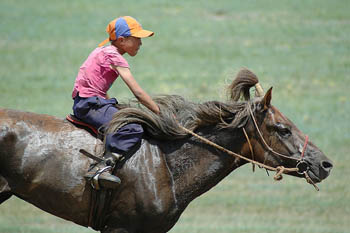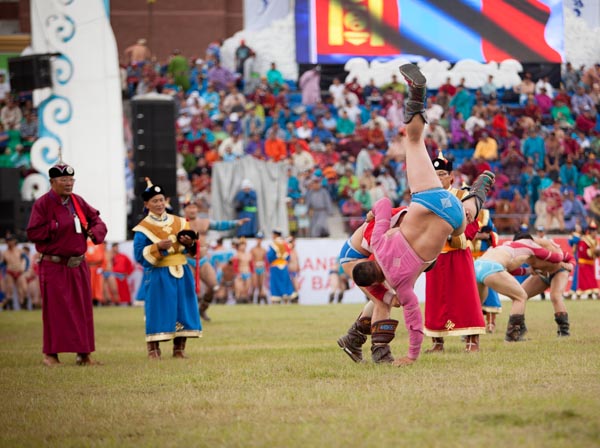

Naadam is the national holiday of Mongolia. It gives rise to festivities each year on July 11th and 12th in Ulaanbaatar and in the rest of the country the following week. The Naadam festival in Ulaanbaatar is the most famous and most prestigious one, but if you get a chance, try to see those held in the rest of the country, there are many fewer people and the atmosphere is much more friendly and authentic. These festivals include three traditional sports in Mongolia, called the "three manly games": horse racing, archery and Mongolian wrestling. |
 |
Mongolian wrestling is the most popular sport, the archery tends to fall into disuse, as we see the development of jacks, considered a new "Manly Game" since 2003.
Races are organized according to age and sex of the horses: geldings, for example, are divided into five age categories, from 2 to 6 and older.
Each Naadam includes at least one race of stallions (AZARGA), and at least three races for geldings. In Ulan Bator, a race for pacing horses is also planned.
The distance traveled by the race is also dependent on the age of horses, 15 km for 2 years, 30 km for horses over 6 years.
The start of the races is very specific: all the horses come together behind a standard-bearer, cross the finish line and follow the official rider until the starting line.
Arrived at the starting line, a whistle gives the signal to start the race, riders turn around and gallop toward the finish line as fast as possible.
Riders are always children, boys or girls, 6 to 12 years. Even if the rider falls, either during the race or at the turn of departure, the horse is not disqualified, but it has a penalty of one rank less .
The first five horses are rewarded: people sing their praises, and they are sprayed with fermented mare's milk (airag) on the rump, neck and cheek.
The arrival is often hectic, as many horses are riderless and must be caught.
The colt which arrived last in the race for two years horses is also distinguished with the (unflattering) title of "rich stomach!"
The rider is not celebrated the same way as the winning horse or his trainer, because he is considered as not having done much in the victory.
But he will be held responsible for the poor performance of " full stomach "...
The sweat of the winning horse is considered to involve happiness, spectators rush to get it back on cloths they will place on their family altar.
Horses, selected on morphological criteria, follow a rigorous training during the weeks before Naadam.
This preparation consists of three elements:
The coach is able to evaluate the progress of his horse, tasting the sweat after the "jumps".
A careful grooming is done for the race: the long manes of the stallions are braided, those of the geldings being cut short.
The forelock is combed and tied with a red link in order to stand upright on the horse's head.
Riders wear traditional dels, with a bib. They ride bareback or with a very light saddle, without stirrups and without shoes to be as lightweight as possible.

This game is the most popular with urban dwellers, who no longer have much contact with the horses.
It differs from other wrestlings by the lack of weight classes.
The rules are simple: the winner is the one who forces the opponent to one knee, back, or posterior to the ground, using any of the traditional movements (mekh).
The traditional dress has embroidered blue pants, heavy boots, a hat of red velvet and a very indented black bolero to ensure that no woman hides among the competitors.
The wrestlers perform the eagle dance (bevekh) before the bout.

This event is open to women, who draw 20 arrows at a 60 meters target, while men shoot 40 arrows at a 75 meters target.
This game tends to disappear, sometimes for lack of participants, in some Naadam outside Ulan Bator.
